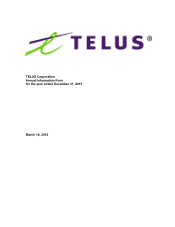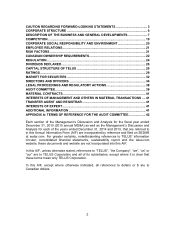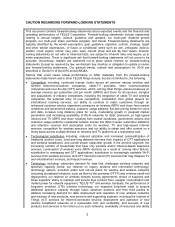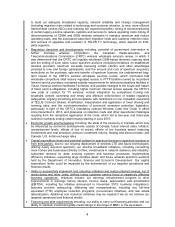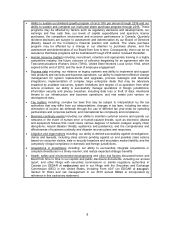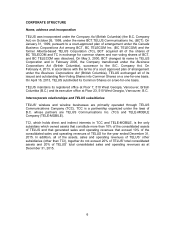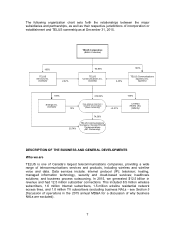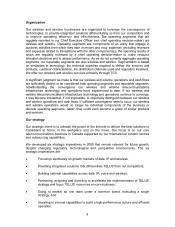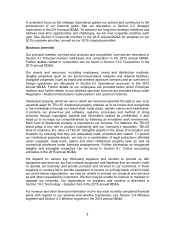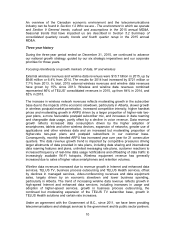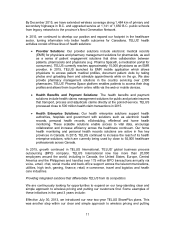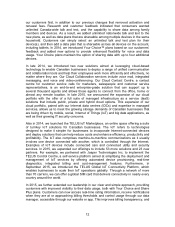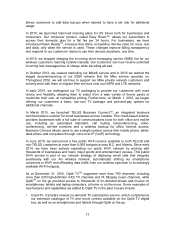Telus 2015 Annual Report Download - page 3
Download and view the complete annual report
Please find page 3 of the 2015 Telus annual report below. You can navigate through the pages in the report by either clicking on the pages listed below, or by using the keyword search tool below to find specific information within the annual report.
3
CAUTION REGARDING FORWARD-LOOKING STATEMENTS
This document contains forward-looking statements about expected events and the financial and
operating performance of TELUS Corporation. Forward-looking statements include statements
relating to annual targets, outlook, guidance and updates, our multi-year dividend growth
program, our multi-year share purchase program, and trends. Forward-looking statements are
typically identified by the words assumption, goal, guidance, objective, outlook, strategy, target
and other similar expressions, or future or conditional verbs such as aim, anticipate, believe,
predict, could, expect, intend, may, plan, seek, should, strive and will. By their nature, forward-
looking statements do not refer to historical facts, are subject to inherent risks and require us to
make assumptions. There is significant risk that forward-looking statements will not prove to be
accurate. Accordingly, readers are cautioned not to place undue reliance on forward-looking
statements. Except as required by law, we disclaim any intention or obligation to update or revise
any forward-looking statements. Our general trends, outlook and assumptions for 2016 are
described in Section 9 of the 2015 annual MD&A.
Factors that could cause actual performance to differ materially from the forward-looking
statements made herein and in other TELUS filings include, but are not limited to, the following:
Competition including: continued intense rivalry across all services among wireless and
wireline telecommunications companies, cable-TV providers, other communications
companies and over-the-top (OTT) services, which, among other things, places pressures on
average revenue per subscriber unit per month (ARPU) and churn for all services; mergers
and acquisitions of industry competitors, including the integration of cable-TV and wireless
companies; the potential entry of new competitors; competition from global players for
international roaming services; our ability to continue to retain customers through an
enhanced customer service experience; pressures on wireless ARPU and churn from market
conditions and government actions, customer usage patterns, flat-rate pricing trends for voice
and data, inclusive long distance plans for voice, moderating growth in postpaid market
penetration and increasing availability of Wi-Fi networks for data; pressures on high-speed
Internet and TV ARPU and churn resulting from market conditions, government actions and
customer usage patterns; residential network access line (NAL) losses; subscriber additions
and retention volumes and associated costs for wireless, TV and high-speed Internet
services; competition for wireless spectrum; and our ability to obtain and offer content on a
timely basis across multiple devices on wireless and TV platforms at a reasonable cost.
Technological substitution including: reduced utilization and increased commoditization of
traditional wireline voice, local and long distance services from impacts of OTT applications
and wireless substitution, and overall slower subscriber growth in the wireline segment; the
increasing number of households that have only wireless and/or Internet-based telephone
services; continuation of wireless voice ARPU declines as a result of, among other factors,
substitution to messaging and OTT applications; substitution to increasingly available Wi-Fi
services from wireless services; and OTT Internet protocol (IP) services that may displace TV
and entertainment services, and impact revenue.
Technology including: subscriber demand for data that challenges wireless networks and
spectrum capacity levels; our reliance on legacy systems and information technology;
technology options, evolution paths and roll-out plans for wireline and wireless networks
(including broadband initiatives, such as fibre-to-the-premises (FTTP) and wireless small-cell
deployment); our reliance on wireless network access agreements; choice of suppliers and
those suppliers’ ability to maintain and service their product lines; supplier concentration and
market power for network equipment, TELUS TV® and wireless handsets; the performance of
long-term evolution (LTE) wireless technology; our expected long-term need to acquire
additional spectrum capacity through future spectrum auctions and from third parties to
address increasing demand for data; deployment and operation of new wireless networks
and success of new products, new services and supporting systems, including the Internet of
Things (IoT) services for Internet-connected devices; deployment and operation of new
wireline broadband networks at a reasonable cost and availability, and success of new
products and services to be rolled out on such networks; availability of resources and ability

